Elizabeth Arden (1920-1930)
Continued from: Elizabeth Arden
Continued onto: Elizabeth Arden (1930-1945)
In the 1920s, Elizabeth Arden became a global cosmetics business. New Salon d’Oros were opened overseas starting with Paris, at 255 Rue Saint-Honoré in 1920, followed by London (1921), Cannes (1924), Biarritz (1925), Madrid (1928), Rome (1928), and Berlin (1928).
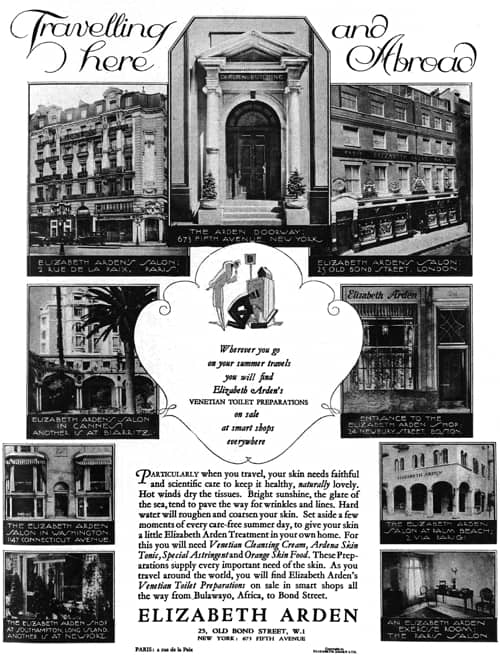
Above: 1926 Elizabeth Arden in New York, London, Boston, Palm Beach, Long Island, Newport, Washington, Cannes, Biarritz and Paris.
In 1923, the Paris salon was moved to the more fashionable Rue de la Paix following Helena Rubinstein relocating her Paris salon to the Rue du Faubourg Saint-Honoré in 1921.
The New York salon was not forgotten and Arden made regular improvements to its fittings and facilities. She also made a great deal of its Fifth Avenue address – even though its entrance was on East 53rd Street – perhaps reminding her clients that Helena Rubinstein’s new salon was on the less fashionable West 57th Street.
In New York, my Salon d’Oro, situated midway between residential and shopping Fifth Avenue, serves the complexion requirements of the New York society woman. The excellence of the building, its location, the spaciousness and beauty of the rooms (which have been further enhanced during the past few weeks) the well-known efficiency of the Venetian Muscle-Strapping, Face Modeling Treatments which are administered by my personally trained assistants, the quiet, exclusive atmosphere, all give my Salon d’Oro a character approached by no similar institution.
(Elizabeth Arden advertisement, 1921)
Arden salons acted as flagships for her products and treatments but most of her cosmetics were sold through department stores and other outlets. By 1923, Arden had opened over 650 accounts with agents and ‘smart shops’ throughout the world, extending as far away as Australia. Some of the department stores that retailed Arden cosmetics also opened Arden salons.
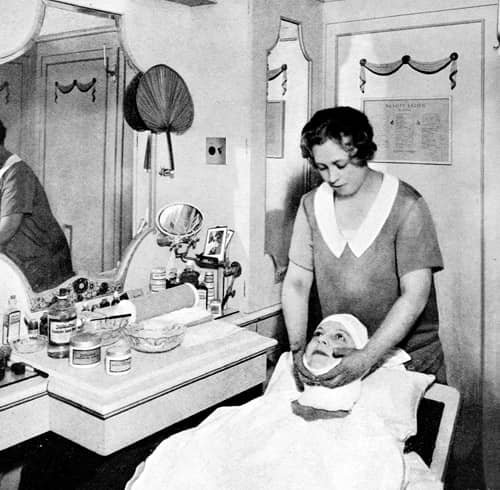
Above: 1928 Elizabeth Arden salon in the David Jones department store in Sydney, Australia.
Though the mail-order business declined in importance it was not entirely done away with. In places like South America, where Arden outlets were, for the moment, unavailable, it was still possible to send away for Arden cosmetics.
Much of the credit for expanding the business during this period was due to Thomas Lewis [1877-1971] whom Arden had married in 1915. He became the general manager of Elizabeth Arden when he returned from war service in 1918, a position he would hold until Arden divorced him in 1934. Lewis rationalised the operations of Elizabeth Arden and put them on a firmer financial footing. In 1921, the Arden Chemical Company was established in New York with a capital of US$500,000 – succeeded by Elizabeth Arden, Inc. in 1928 – and the wholesale business was expanded across the United States, Canada and overseas.
A second person of significance to Arden’s growing global business was Edward (Teddy) Marsden Haslam. It is generally accepted that Arden first met him when he was working as a buyer at Harrods in London. Harrods was Arden’s first British department store account and the Harrods department store chain would go on to become Arden’s biggest foreign customer before the Second World War (Manufacturing Perfumer, 1938).
Haslam had management experience and was also a trained chemist. Along with Elizabeth Arden and Tom Lewis he became a director of Elizabeth Arden Ltd., London when it was established in 1925 He was also made general manager of the new company and his duties included supervising the operations of a factory in the Coach and Horses Yard in Westminster behind New Bond Street which opened in 1923. Production of Arden products remained there until a larger facility was opened in North Acton in 1939.
The British firm controlled Elizabeth Arden’s operations in Britain and the British Empire (except Canada), Europe (except France) and South America. This changed after new subsidiaries were established in Canada (1929), Germany (1934), Italy (1934) and South America but, by 1938, it still accounted for about half of all foreign sales. Haslam was loyal to Arden and remained with her for the rest of his working life.

Above: Elizabeth Arden counter in Selfridges department store in Oxford Street, London. One of many outlets opened in the 1920s.
Arden’s French interests, including Elizabeth Arden SA established in 1920 and the Paris salon, were run by her younger sister, Jessie Gladys Graham [1884-1970], who became Gladys Maublanc de Boisboucher after her marriage to Henri Maublanc de Boisboucher [1885-1948] in 1932. Despite disliking her husband, Arden remained close to her sister and handed the French business over to her to avoid paying French taxes (Woodhead, 2003, p. 144).
Gladys is credited with sourcing a number of French products for Arden. In the 1920s, this included fragrances from Babani, a fashion house on the Boulevard Gassmann started by Vitaldi Babani in 1894. The fragrances – Nandita, Extrait d’Ambre Gris, Giardini, Ambre de Delhi, Ligéia, Ming, Afghani, Chypre, Sousouki, Jasmin de Corée and Yasmak – were developed by Vitaldi’s son Maurice. Arden imported them into the United States, beginning in 1922. Babani developed a number of other fragrances for Arden during the 1920s including four fragrances named for her – Mon Amie Elizabeth (1927), La Joie d’Elizabeth (1928), Le Rêve d’Elizabeth (1928), and L’Amour Elizabeth (1929).
Advertising
Arden began to advertised widely soon after her first salon was opened in 1910 and her advertising expenses were large when you take into account the size of the firm. By comparison, in February, 1926, when Pond’s, a very large corporation, spent US$60,000 on magazine advertising in the United States, Elizabeth Arden, a much smaller company, spent US$20,775 (Woodhead, 2003, p. 145).
Arden rarely used her own image in advertising so she did not become the face of her business to the same extent as Helena Rubinstein. Early on, she repeatedly used a rather bland image of a woman looking over her shoulder but this changed in the 1920s after Henry Sell – the editor in chief at Harper’s Bazaar – introduced her to Baron Adolphe Edward Sigismund de Meyer [1868-1946]. De Meyer developed an iconic image of a bandaged head that became the face of Arden for decades.
Lewis and Woodworth suggest that the French model de Meyer used was Cecille Bayliss (Lewis & Woodworth, 1973, p. 113); however, I can find no record of her existence. In 1935, Arden applied for a trademark for the image of the bandaged face which used the French model Roberta Cusey. Arden continued to use variations of this image of the bandaged head as late as 1946 but by then Roberta had been replaced with a look-alike mannequin.
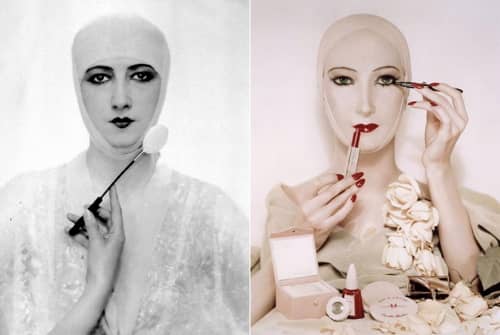
Above: Left: 1929 Photograph for an Elizabeth Arden advertisement taken by Baron Adolphe de Meyer. Right: 1948 Photograph taken by Erwin Blumenfeld [1897-1969] which combines the head of a mannequin with the arms and hands of a model.
Sell is also credited with introducing Arden to Elisabeth (Bessie) Marbury [1856-1933] sometime around 1926. Marbury tried to cultivate Arden to have an interest in the arts and also attempted to help her become better connected socially. On both counts she met with limited success. Arden spent many weekends at Marbury’s ‘Lakeside Farm’ in Maine and, in 1929, Arden bought ‘The Gables’, an estate next to Marbury’s property, renovated the house and renamed it ‘Maine Chance’. When Marbury died in 1933, Arden bought Lakeside Farm, eventually combining it with Maine Chance.
Salon treatments
By 1922, Arden was referring to her signature Muscle-Strapping routine – sometimes referred to as Muscle-Strapping and Face Molding – as the Muscle-Strapping Skin-Toning method. This may have been done to distinguish her treatment from other muscle-strapping systems such as the one provided by her one-time employee, Dorothy Gray.
Three fundamental things, to keep your skin fair and smooth, to keep the curves of face and neck firm and young? Elizabeth Arden’s Muscle-Strapping Skin-Toning method does such miracles of good for the skin. The wonderful treatments given in her famous Salons are based on Cleansing, Nourishing, Toning and Tightening. If you will do these three things at home according to Elizabeth Arden’s scientific method—faithfully, thoughtfully, morning-and-nightly!—you can have the loveliest skin that ever blossomed.
(Elizabeth Arden, 1928, p. 8)
Although the name may have changed little else appears to have altered in Arden’s salon facials until the introduction of the Vienna Youth Mask in 1927. Included as an extra in a facial, this electrical treatment was said to rejuvenate by stimulating blood circulation. It caused vasodilation of the blood vessels, a reaction to the warmth generated by the diathermic treatment. Though the results might be dubious, it was a great commercial success.
For only one of Elizabeth Arden’s many means to youth is it absolutely necessary to go to a Salon, and that is her Vienna Youth Mask. This is the discovery of a certain famous professor of the University of Vienna, and through Miss Arden alone is it available in this country. It achieves rejuvenation by deep, natural stimulation of circulation, it possesses none of the dangers of plastic surgery. The Vienna Youth Mask is the perfect remedy for flabby flesh or sagging muscles.
(Elizabeth Arden advertisement, 1928)
See also: Diathermy and Arden Vienna Youth Mask
Exercise and weight control
Dress fashions of the 1920s emphasised thinness and exposed more of the arms and legs to view. This added to the concerns many women had about their body weight and contributed to the ‘reducing’ fad that marked the decade.
Helena Rubinstein and Elizabeth Arden both capitalised on this trend by introducing exercise programs and other reducing treatments to help women lose weight and firm up soft and flabby tissue. By the end of the decade, Arden had created a Department of Exercise and when she opened her new New York salon at 691 Fifth Avenue in 1930 it came complete with a gymnasium.

Above: 1922 Exercise room in the London Salon d’Oro. There is a mat on the floor and a gramophone player for accompanying music.
Women who participated in an Arden salon exercise program would change into a gym tunic before being weighed and measured. They were then massaged with a rolling machine before being taken through a set of gymnastic exercises.
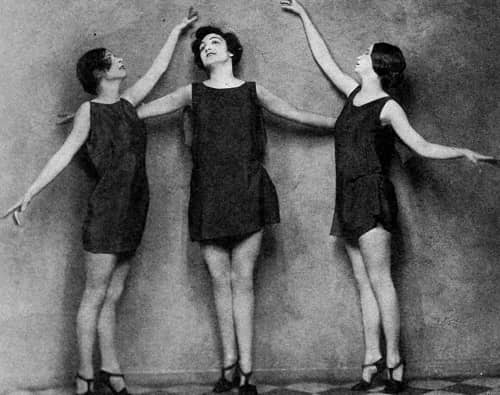
Above: 1927 Elizabeth Arden gym tunics.
The exercise program came in six-part parts: 1. Doughboy to wake up the circulation; 2. In-and-Out, to correct constipation; 3. Scissors to mold the hips and thighs; 4. Chin-Toe and Jack-Knife to for the neck, hips and abdomen; 5. Twist-Pull-and-Squeeze for the waist and shoulders; and 6. Balance for poise and grace. Some of these appeared to have similarities with yoga exercises. Arden had been doing these for some time including head stands.
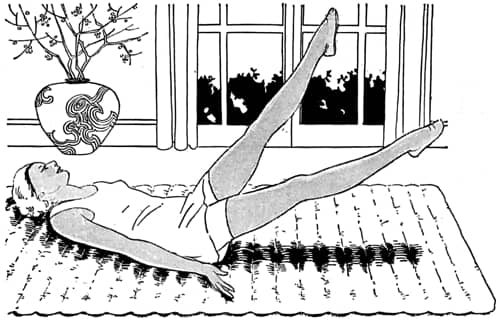
Above: 1927 Elizabeth Arden scissor exercise.
Also see the company booklet: Exercises for Health and Beauty (c.1924)
The exercises were followed by a session on the ‘reducocycle’ and then a full-body Scandinavian massage. The program lasted about two hours but clients could delete some sections with a corresponding reduction in the fee.
In 1923, Arden put the salon exercise routine on a set of three double-sided gramophone records so that women could do the program at home. Included with the recordings was a set of photographs showing the various movements, a measurement chart and a diet schedule. Arden also sold a Satin Mat on which women could do the exercises.
Elizabeth Arden’s Venetian Toilet Preparations are on sale in the smartest shops throughout the world.
But Elizabeth Arden goes still further in her definition of youth.
“In every cell of your body,” she says, “you must feel tinglingly alive. No excess fat, no under-nourishment Nerves at rest, muscles lithe and responsive”.
In exercise, as in the care of the skin, Miss Arden stands for all that is best and surely successful. Her specially planned exercises for women are famous in the smart world. They accomplish definite results in a simple, direct way that appeals to thinking women. Body discipline is assured as well as body beauty.
And again, the perfection of the Salon method is available for all. Elizabeth Arden Exercise Records, playable on any phonograph, enjoyably teach a series of rhythmic movements that will regulate contours, stimulate circulation, and bring poise and grace as sure reward.(Elizabeth Arden advertisement, 1929)
The diet schedule included with the exercise program may have been influenced by Lulu Hunt Peters’ [1873-1930] best-selling book ‘Diet and health: With key to the calories’. Published in 1918, it included a step-by-step diet plan and was the first book to popularised the idea of reducing weight by counting calories.
Other Arden salon treatments to help women reduce were Paraffin Wax Treatments and Hot Vapour Cabinets. These induced perspiration producing a measurable weight loss after the treatment.
See also: Paraffin Wax Treatments
Arden also sold a number of spot-reducing devices for use at home on the hips, waist, thighs and backs to reduce fat in those areas. For example, she imported the Frances Jordan Reducer into Britain for sale there.
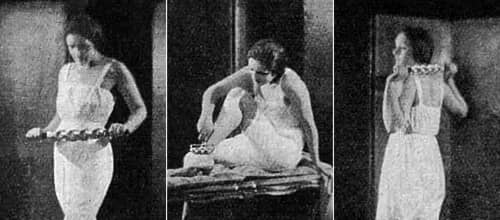
Above: 1925 Spot rollers for sale from Elizabeth Arden in Britain.
In 1922, Arden added a reducing soap to her existing Venetian Special Reducing Lotion. Amiral Soap (Savon Amiral) was an old French soap made with ox bile. The makers claimed was absorbed into the skin to dissolve underlying fat. Arden was not the first to import it into the United States and it had also been available for many years across Europe and Great Britain before Arden decided to add it to her inventory.
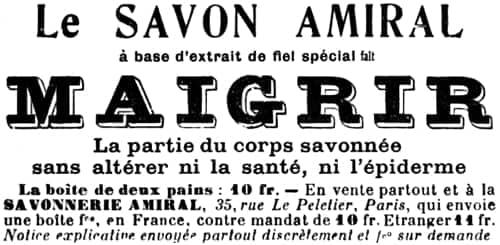
Above: 1911 Savon Amiral.
Amiral Reducing Soap: “The preparation of a famous French chemist. Formulated on scientific principles of ingredients known to break down fatty tissue. Reduces only that portion to which it is applied. Its use is agreeable and efficacious. Splendid for reducing double chin, thick ankles, wrists, hands, waistline, or any part. Special directions with each cake.”
Venetian Special Reducing Lotion: “Excellent to use instead of the Reducing Soap if you prefer a lotion. Removes superfluous fatty tissue from upper arms, shoulders, hips and abdomen, where it is applied with the palm of the hand. To reduce a double chin it is effectively applied with the Arden Patter.”
Skin-care
Most of the skin-care products Arden included in her basic skin-care routine – Venetian Ardena Skin Tonic, Venetian Cleansing Cream, Venetian Special Astringent, Venetian Orange Skin Food, Venetian Muscle Oil, and Venetian Velva Cream – had been available before the First World War.
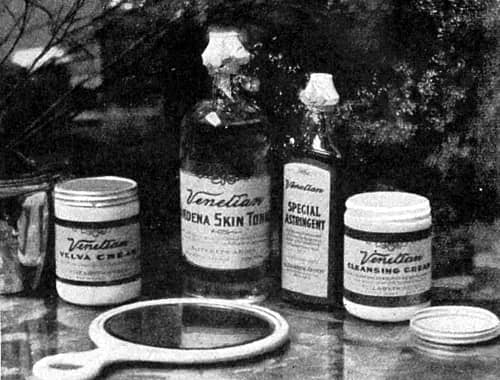
Above: 1923 Venetian Velva Cream, Venetian Ardena Skin Tonic, Venetian Special Astringent and Venetian Cleansing Cream.
The basic regime did not change much during the 1920s except for the addition of an afternoon treatment which used Venetian Anti-Wrinkle Cream, an astringent cream made with eggs introduced in 1921.

Above: 1922 Venetian Anti-Wrinkle Cream.
Venetian Anti-Wrinkle Cream: “A nourishing and astringent cream. Its mellow richness is due to the fresh eggs of which is made. Fills out fine lines and wrinkles, leaves the skin smooth and firm.”
For Morning—Dip a pad of damp absorbent cotton into Ardena Skin Tonic, then into Cleansing Cream, and “wash” the face and neck. Remove with soft, imported Arden Tissues. A patting with Special Astringent is excellent to firm the contour. Apply Muscle Oil over lines and wrinkles, and Orange Skin Food—or the delicate Velva Cream. Remove with the Tissues. Clear the eyes with Special Eye Lotion. Protect your skin with Amoretta Cream. Rouge, if necessary, a dusting of Ardena Powder and you are ready for the day and at your best.
AFTERNOON—First a generous application of Venetian Cleansing Cream (applied with a damp pad moistened with Ardena Skin Tonic). Next, the soothing mellowness of Anti-Wrinkle Cream, followed if possible by ten minutes of rest. A brisk patting of Skin Tonic. Then the magic touch, a sparing smoothing on of Ultra-Amoretta Cream, so softly receptive to discreet rouge, and a dusting of Ardena Powder. A touch of emphasis for the lips—Venetian Rose Colour or Venetian Lip Paste—and you go to tea or dinner, all your loveliness recaptured.
AT NIGHT—The skin must be freed from all secretions, powder or dust that clog the pores. Follow the morning “washing” treatment, always with an upward movement. Remove with Ardena Cleansing Tissues. For a too soft throat and cheeks, give a five minute patting with a firm pad of cotton squeezed out of water and wet with Special Astringent. Dry, and pat in Muscle Oil over wrinkles and hollows. Apply Orange Skin Food with a quick upward moulding stroke. Leave a little Skin Food and Muscle Oil to be absorbed during the night by the stimulated tissues.(Elizabeth Arden advertisement, 1929)
The only other addition to the basic routine during the 1920s was a make-up line, Crême de France (1922), a cream alternative to Lille Lotion. Recommended for women with dry skin it was used as a skin protectant and powder foundation. If women found that it was too heavy it could be thinned with Venetian Ardena Skin Tonic or Venetian Lille Lotion.
Crême de France: “A soothing, protecting cream for the average skin, and especially good for a dry one. Melting, vanishing, fragrant—it prevents that dry roughness and burning that follow exposure to sun and cold. It smooths away those spots of flake and scale that often mar a complexion wanting in natural oils.”
Skin types
Though Arden recognised that there were women with ‘oily’ and ‘dry’ skins, unlike Helena Rubinstein she made few product allowances for different skin types. Rubinstein had a range of skin cleansers that clients could select according to their skin type and she added the combination skin type to her skin-care routines in 1929.
See also: Helena Rubinstein (1915-1930)
By comparison, every Arden skin-care routine started with the same two products: Venetian Cleansing Cream and Venetian Arden Skin Tonic. When it came to ‘nourishing’ the skin, Arden considered Venetian Orange Skin Food best suited for dry skin while Venetian Velva Cream followed by Venetian Special Astringent was recommended for women with oily skin. However, these products were usually selected according to the fullness of the face – fat or lean – not whether the face was oily or dry.
The only Arden products specifically designated for dry skin in the 1920s were Cream Ultra-Amoretta, Crême de France, Venetian Ultra-Lille Lotion, and Venetian Rouge Amoretta, all forms of make-up.
Lines and wrinkles
Along with the Muscle-Strapping Skin-Toning treatment Arden continued to promote her Venetian Muscle Oil, Venetian Orange Skin Food and Venetian Velva Cream to remove lines and wrinkles, and Venetian Special Astringent to tighten flabby skin and restore youthful contours. Patting was still the order of the day.
Elizabeth Arden does not sanction the use of massage. Muscle-Strapping Skin-Toning—molding of the facial muscles by clever scientific manipulation—is perhaps her greatest contribution to the science of skin-treatment. It consists of smart rapid patting following the line of muscles of face and neck. The patting is always upward, to lift the muscles and overcome their natural tendency to droop and sag. It is done tellingly, to stimulate circulation and increase the functional activities of the tissues. The muscles of cheeks, throat and neck are molded with skilful fingers to preserve and restore the firm round contours of youth. And with Muscle-Strapping Skin-Toning, creams and lotions are used to Cleanse, Nourish and Tone the skin.
(Elizabeth Arden, 1928, p. 8)
At home, women could still buy and use the Ardena Patter. Helena Rubinstein also sold a mechanical device to stimulate circulation. In her case it was a roller, the Valaze Massagette.
Freckles, tan and sunburn
As the suntanning craze gathered pace during the 1920s, clients returning to the city from summer holidays in the country could go to an Arden salon for an Après l’Eté (after summer) salon treatment. This would ‘restore’ their skin, bleach out their tan lines and even out their skin tone.
Arden was already selling two skin bleaches – Venetian Bleachine Cream and Venetian Special Bleach Cream (single and double strength) – but she added another, Venetian Anti-Brown Spot Ointment, in 1922.
The product must have been strong as the skin was first protected with Venetian Orange Skin Food before the Venetian Anti-Brown Spot Ointment was applied where needed. Left on for 3-10 minutes, depending on the sensitivity of the area on which it was applied, the ointment was removed with Venetian Muscle Oil. The skin was then soothed with Venetian Orange Skin Food before the treatment was finished with Venetian Ardena Skin Tonic.
Venetian Anti-Brown Spot Ointment: “A creamy tingling ointment which is smoothed on the face in the form of a mask, after the skin has been thoroughly cleansed, toned and nourished. It rejuvenates the tissues amazingly, stimulates the circulation through every muscle of the face and neck, galvanizes every torpid cell. But most important, it is helpful in erasing marks of tan and sallowness, moth patches and liver spots and those discolorations that betray an acid condition of the blood.”
The prickling sensation produced by the Venetian Anti-Brown Spot Ointment may have been due to a bleach or an exfoliant but it is possible that it also contained another irritant. Arden suggested that moth patches and liver spots were due to poor circulation and irritants were commonly used in cosmetics as circulation improvers.
See also: Circulation Creams
Clients who wished to lightly tan their skin or avoid tanning altogether could protect themselves with shade, apply powder over an Arden foundation – such as Cream Amoretta or Cream Ultra-Amoretta – or use one of Arden’s liquid powders such as Venetian Lille lotion or Venetian Ultra-Lille Lotion. Most of these preparations were not really suited to the growing summer beach culture and Arden added Venetian Waterproof Cream in 1922 as a skin protectant when bathing. It was pearly pink in colour which suggests that it could have provided some sun protection, made more so if the face was powdered after swimming.
Venetian Waterproof Cream: “A light, fluffy cream, pearly in color. It gives an exquisite dull lustre to neck and arms and is perfect for evening make-up. Being impervious to water it is a splendid protective cream for summer-time swimming and gives a velvety finish under powder.”
In 1928, Arden launched Ardena Protecta Cream in four shades, sold in tubes as well as jars to make it easier to take to the beach. Provided in White, Rachel, and a pinkish Naturelle shade, the cream also came in Bronze for use on tanned skin. It was probably similar in formulation to Venetian Waterproof Cream but came in a wider shade range.
Ardena Protecta Cream: “[A] thick, velvety preparation which blends smoothly into the skin and gives it an appearance of soft delicacy. But—more than that—it acts as an invisible waterproof and weatherproof film to protect the skin from freckling, burning and coarsening. Its imperviousness to water makes it ideal for use on the beach.” Shades: Pure White, Rachel, Naturelle, and Bronze.
Though generally promoted for visits to the beach, Arden also suggested it could be used as a foundation for evening make-up.
Blackheads, enlarged pores and acne
In 1926, Arden added Venetian Healing Cream for pimples and other blemishes and followed this with Spotpruf Cream (1928) and Spotpruf Lotion (1930). These products were combined with exisiting lines such as Venetian Anti-Brown Spot Ointment and Venetian Acne Lotion.
After you have cleansed your skin night and morning with Cleansing Cream, pat with Spotpruf Lotion. At night, pat a thin film of Spotpruf Cream on the affected areas.
For the oily skin with persistent eruptions, begin with an application of Anti-Brown Spot exactly according to directions.
Remove Anti-Brown Spot with Cleansing Cream and Tissues. Wipe thoroughly and gently. Press out surface gatherings. Pat on Acne Lotion. For daytime, powder directly over the Lotion; at night, follow with Healing Cream, which is left on. Given nightly, this treatment has successfully cleared many cases of acne.(Elizabeth Arden advertisement, 1930)
Venetian Healing Cream: A healing and remedial cream to be used for pimples, eruptions, acne, eczema and other blemishes on the skin. Apply with absorbent cotton over the affected spots, as soon as they appear. It soothes and heals infected tissues, whitens inflamed skin.”
Spotpruf Lotion: “[A] fresh, soothing liquid ideal for daytime use. Pat it on before the make-up.”
Spotpruf Cream: “All the healing properties of Spotpruf Lotion have been included in this important preparation to be used overnight.”
By 1923, Arden had also introduced Venetian Ardena Masque to free the skin of ‘eruption causing poisons’.
Venetian Ardena Masque: “Once or twice a week the skin should be purified and awakened by the use of this wonderful corrective. It is the only substitute which can approach one of Elizabeth Arden’s expert Salon Treatments. It is especially beneficial for oiliness and eruptions. It stimulates the circulation, freeing the skin of poisons which cause eruptions. It firms the underlying muscles, strengthens and smooths the contour, corrects wrinkles and flaccidity. If your skin shows the effects of neglect, of relaxed condition, or the “wilted” look of fatigue, brace and tone it with this wonderful rejuvenating treatment. It revives the weariest tissues.”
Also see the booklet: The Quest of the Beautiful (1923)
Hands and nails
In 1923, Arden added Venetian Milk of Almonds and Venetian Velva Liquid to her hand-care range, the later product also recommended as a general body lotion.
Venetian Milk of Almonds: “Softens and nourishes the hands. A real skin food, creamy and fragrant, made with fresh almonds.”
Venetian Velva Liquid: “An exquisite lotion for the hands and body. A few drops, smoothed on the skin after bathing, prevent redness, roughness and chapping. Keep a bottle of this fragrant soothing liquid always nearby, and use it faithfully every time you wash the hands.”
For nails there was English Nail Paste, said to be fully imported, and French Nail Polish, a clear, pink polish that, despite the name, was probably sourced locally.
English Nail Paste: “An exquisite cream that heals the cuticle, tints the nails, and imparts a lasting polish.”
French Nail Polish: “A splendid liquid polish, that flows on evenly, dries at once, and gives the nails a smooth smart lustre. Tinted a delicate pink. A wonderful waterproof polish that keeps the nails beautifully lustrous for several days.”
In general, this product segment continued to be weak and this would become a major problem in the 1930s when nail polish became more important.
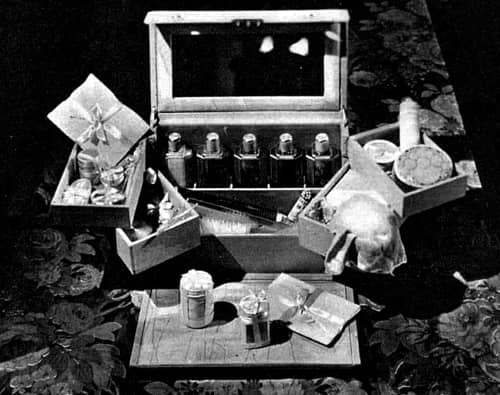
Above: 1929 Elizabeth Arden Beauty Box.
Make-up
The use of make-up became more acceptable during the 1920s. Arden added some new items to her range and increased the shade range of her exisiting lines which included making allowances for the darker skin tones created by the suntanning craze.
Foundations and powders
By the end of the decade Arden had a wide range of creams and lotions that could function as a foundation for powder including new additions like the previously mentioned Crême de France, Venetian Waterproof Cream, and Ardena Protecta Cream.
At the start of the decade, most Arden face powders were named by the single shade in which they came, e.g., Poudre de Lilas and Venetian Poudre Olivâtre. She continued to do this for a while, adding Arden Ocre Powder in 1922 to help cater for darker skin tones. However, by 1928, Arden had rationalised this naming practice and only three named face powders remained: Venetian Flower Powder, Poudre d’Illusion and Venetian Poudre de Soir. Venetian Poudre de Soir – for electric lighting – still only came in a single pearly-pink tint but the other two were now sold in a wider variety of shades: Venetian Flower Powder in White, Cream, Maréchal Neil, Naturelle, Rose, Special Rachel, and Spanish Rachel; Poudre d’Illusion in White, Illusion, Rachel, Mat Foncé, Poudre de Lilas, Ocre, Minerva (1925), and Banana (1926).
In 1929, Poudre d’Illusion was renamed as Ardena Powder and the Illusion shade as Ardena. The change was maintained in most countries but Arden appears to have backtracked on the name change in the United States after the stock market crash in October, 1929.
Ardena Powder: “A pure, vaguely scented powder, made for those who demand the extreme of quality.” Shades: Ardena, Rachel, Ocre, Minerva, Banana, Mat Foncé, and White.
In 1929, in a further response to the increased level of suntanning, Arden introduced her Rosseta-Bronze make-up, the same year that Helena Rubinstein introduced her Gypsy Tan make-up. This added Light Rosetta, Medium Rosetta and Dark Rosetta to her Poudre d’Illusion/Ardena Powder. She also added Bronze shades to Venetian Lille Lotion (Light Bronze, Dark Bronze) and Venetian Ultra-Amoretta Cream (Bronze) and introduced a new artificial tan called Arden Bronze in two shades.
Ardena Bronze: “[T]he simplest and most satisfactory way of acquiring a coat of synthetic tan.” Shades: Light Bronze, and Dark Bronze.
Mention should also be made of No-Shine (1929), a colourless liquid used to prevent shine on the nose or forehead. It was worked in with the fingers and then powder was pressed in just before it was quite dry.
No-shine: “[I]f applied just before powdering the face, gives a matt finish and makes it unnecessary to powder the nose for the rest of the day.”
Rouge and lipstick
Arden continued to sell her Venetian Rose Color and Venetian Rouge Amoretta through the 1920s. The liquid Venetian Rose Color was still produced in a single shade but the creamy Venetian Rouge Amoretta came in Light (ash blonde), Medium (fair complexions), Dark (dark brunette), and Geranium (light blondes) tints by 1923, with the Geranium shade replaced by American Beauty by 1928.
In the early 1920s, Arden added some new lip pastes and lip pencils some of which were indelible. These remained throughout the rest of decade but there were no additions to the limited range of colours.
Venetian Arden Lip Stick: “A new popular lip stick in a smartly chased gilt case, slender, convenient and flattering. Does not easily rub off.” Shades: Bright, Medium, and Maroon.
Venetian Fleurette Lip Pencil: “Another very attractive lip stick, prettily packaged in a French Flowered Box.” Shades: Rouge, Naturelle, and White.
Venetian Indelible Lip Paste (Salve): “A smart cherry salve, especially good for evening. Indelible, flattering.” Shades: Light, and Dark.
Eye make-up
In 1923, Arden added Arden Liquid Cosmetique to darken lashes and brows. It appears to have been resilient requiring Venetian Eyelash Grower to remove it.
Arden Liquid Cosmetique: “Darkens and grooms the lashes, makes them glossy and lovely. Darkens the brows, denning them in a smooth line that is smart and becoming.” Shades: Dark Brown, Brown, and Black.
Arden also extended the shade range of her Venetian Eye Sha-Do adding Blue, Gray Blue, Gray Brown and Black to the original Brown shade by 1923, with Medium, Light Brown, Dark Brown, Dark Blue, Green and Violet shades added by 1928. Arden recommended selecting these colours according to the colour of the eye: Blue, Medium, or Dark Blue for blue eyes; Dark Brown for deep brown eyes; Light Brown or Gray Brown for gray and hazel eyes; Violet, for blue or violet eyes; and Black if the eyes were really dark.
In 1929, Arden introduced Venetian Eye Sha-Do Paste, a cream eye shadow in a more limited shade range which, for some reason, were given French rather than English names.
Venetian Eye Sha-Do Paste: “The loveliest way of adding colour and depth to the eyes.” Shades: Bleu Corbeau, Brun Clair, Chatain Foncé, Violet Foncé, Noir, and Vert Mousse.
Colour coordination
As previously indicated, Arden continued to coordinated her make-up colours by complexion, hair and eye colour. A good example of this is her Rosseta-Bronze make-up plan introduced in 1929.
BRUNETTE
Hazel Eyes, Black-Brown Hair, Olive Skin
Bronze Ultra-Amoretta Cream. Bright Indelible Lip Paste for rouge and lips. Light Rosetta Powder. Green Eye Sha-do. Black Mascara.BLONDE
Light Blonde (ashy) Hair, Light Blue Eyes, Fair, Transparent Skin
Dark Bronze Lille Lotion. Light Amoretta Rouge. Light Rosetta Powder. Bright Lip Paste. Blue Eye Sha-do. Groom brows and lashes lightly with Eyelash Grower and touch lashes with brown eyebrow pencil.RED HAIR
Green-Blue Eyes, Fair Skin
Bronze Protecta Cream. Light Amoretta Rouge. Light Rosetta Powder (if make-up is desired darker, use medium Rosetta Powder). Bright Lip Paste. Green Eye Sha-do. Groom brows and lashes lightly with Eyelash Grower.WHITE HAIR
and Brown Eyes
Any foundation (Ultra-Amoretta is especially good). Indelible Lip Salve on cheeks and lips. Medium Rosetta Powder, if light make-up is desired, use Light Rosetta Powder.(Elizabeth Arden advertisement, 1929)
Although not extensive, Arden’s make-up range was comparable to other companies of the time, as were her colour coordination suggestions. In the 1920s, most cosmetic companies matched rouge and lipstick, and recommended selecting face powder by complexion and eye shadow by eye colour.

Above: 1930 Elizabeth Arden Treasurette Box.
End of the decade
By the late 1920s, the beauty business was booming and attracting investment. New beauty companies were founded while others were merged, acquired or expanded. Dorothy Gray was bought by Lehn & Fink in 1927, and Helena Rubinstein sold her American business to Lehman Brothers in 1928. Arden was reputedly offered US$15 million for her business at the beginning of 1929 but turned it down (Lewis & Woodworth, 1973, p. 144) so missed out on the windfall presented to Helena Rubinstein in the 1930s. Arden also resisted floating her business on the share market, a major difference between her and Helena Rubinstein.
See also: Helena Rubinstein (1930-1945)
Many cosmetics companies updated or moved their New York salons in the 1920s. Dorothy Gray relocated to the new Dorothy Gray building at 683 Fifth Avenue in 1928 and Helena Rubinstein shifted her New York salon to 8 East 57th Street in 1929. In August, 1929, just before the stock market crash in October, Arden took out a lease on part of the ground floor as well as five upper floors of the Aeolian Building at 691 Fifth Avenue. She moved her New York salon there in the new year and bought the building in 1944.
Timeline
| 1920 | Elizabeth Arden SA established in France. Paris salon opened at 255 Rue Saint-Honoré. Salon opened in Detroit. New Products: Lemonies Soap. |
| 1921 | Arden Chemical Company founded in New York. London salon opened at 25 Old Bond Street. New Products: Venetian Anti-Wrinkle Cream. |
| 1922 | Arden begins importing Babani perfumes into the U.S. New Products: Venetian Crême de France; Venetian Waterproof Cream; Venetian Anti-Brown Spot Ointment; and Arden Ocre Powder. |
| 1923 | Paris salon moved to 2 Rue de la Paix. London factory opened in Westminster. Recorded exercise routine. New Products: Venetian Milk of Almonds; and Arden Liquid Cosmetique. |
| 1925 | Elizabeth Arden Ltd. established in London. |
| 1926 | Salon opened in Chicago. New Products: Venetian Healing Cream. |
| 1927 | Salons opened in Biarritz and Cannes. Vienna Youth Mask introduced. |
| 1928 | Arden Chemical Company succeeded by Elizabeth Arden, Inc. Salons opened in Madrid, Rome and Berlin. New Products: Spotpruf Cream; and Ardena Protecta Cream. |
| 1929 | Elizabeth Arden of Canada Ltd. established in Toronto. Elizabeth Arden Reality purchases Connecticut Avenue site in Washington. New Products: Ardena Bronze; and No-Shine. |
| 1930 | New York salon moved to 691 Fifth Avenue. New Washington salon opened. New Products: Spotpruf Lotion. |
Continue to: Elizabeth Arden (1930-1945)
First Posted: 29th October 2018
Last Update: 24th September 2023
Sources
Allen, M. (1981). Selling dreams: Inside the beauty business. London: J. M. Dent & Sons Ltd.
Elizabeth Arden. (1923). The quest of the beautiful [Booklet]. USA: Author.
Elizabeth Arden. (1928). The quest of the beautiful [Booklet]. USA: Author.
Elizabeth Arden made a fortune by breaking all the rules. (1938). Manufacturing Perfumer, November, 348-349.
Hunt Peters, L. (1918). Diet and health: With key to the calories. Chicago: The Reilly & Lee Co.
Lewis, A. A., & Woodworth, C. (1973). Miss Elizabeth Arden. London: W. H. Allen.
Peiss, K. (1998). Hope in a jar: The making of America’s beauty culture. New York: Henry Holt and Company.
Shuker, N. (1989). Elizabeth Arden. Cometics entrepreneur. Englewood Cliffs, NJ: Silver Burdett Press.
Woodhead, L. (2003). War paint. Miss Elizabeth Arden and madame Helena Rubinstein their lives, their times, their rivalry. London: Virago Press.
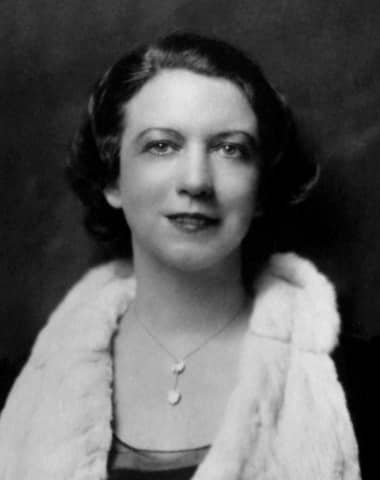
Florence Nightingale Graham [1881-1966] a.k.a. Elizabeth Arden.
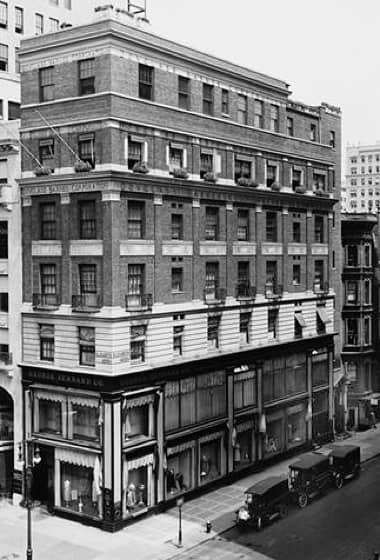
1922 Elizabeth Arden salon at 673 Fifth Avenue, New York. Arden moved here in 1915 and stayed until 1930. The portico entrance to the salon can just be seen on the extreme right of the building, just behind the last parked automobile.

The portico entrance on East 53rd Street to the Elizabeth Arden salon at 673 Fifth Avenue, New York. This may be the original red door.
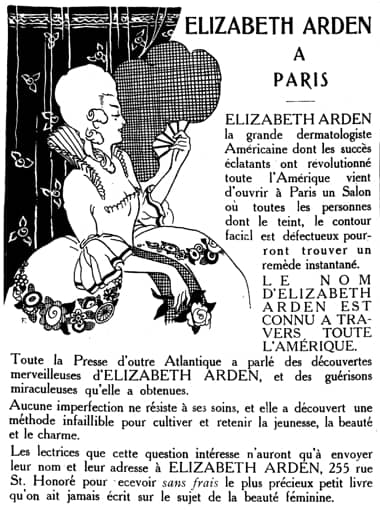
1920 Elizabeth Arden (Paris).
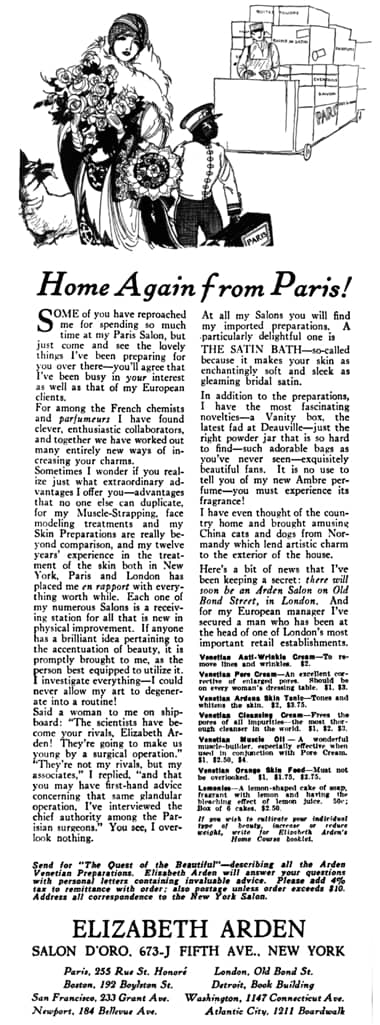
1921 Elizabeth Arden.
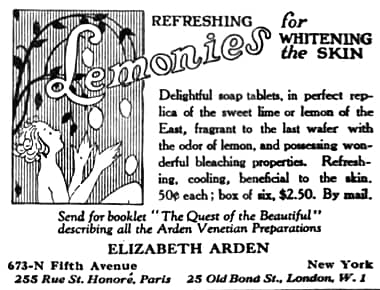
1921 Elizabeth Arden Lemonies Soap Tablets.
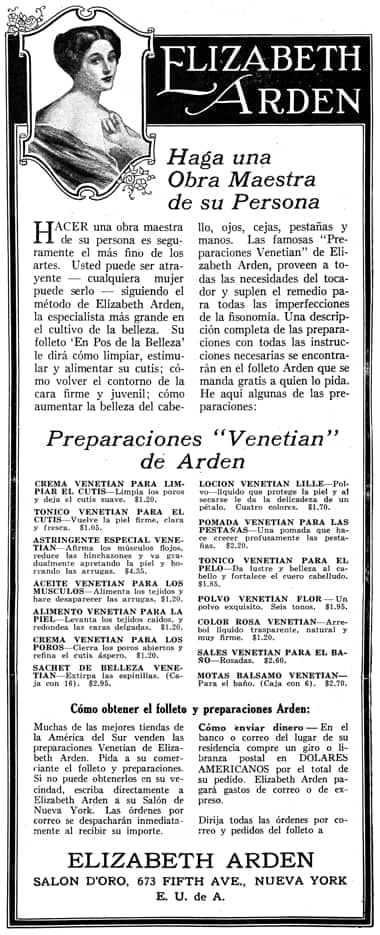
1921 Elizabeth Arden sold by mail order in South America.
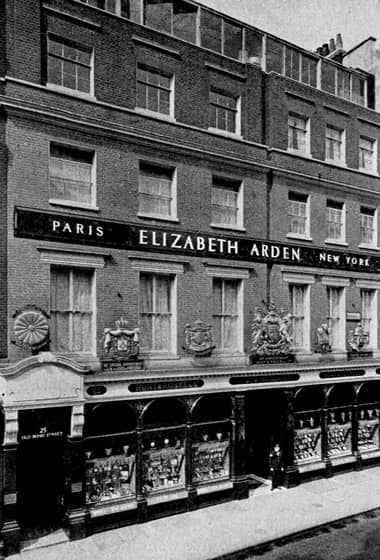
Elizabeth Arden Salon d’Oro, London opened in 1921. The ground floor was occupied by S.W. Benson, a London watch and clockmaker, and gold and silversmith.
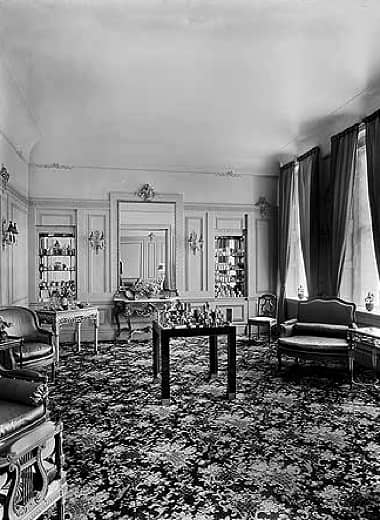
1922 Waiting room in the Elizabeth Arden Salon d’Oro, London with a display of Arden products on the table and rear shelving.
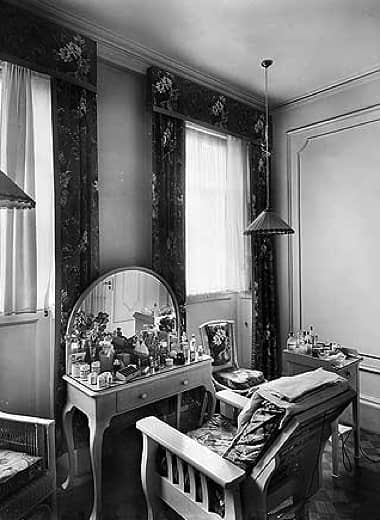
1922 Treatment cubicle in the Elizabeth Arden Salon d’Oro, London.
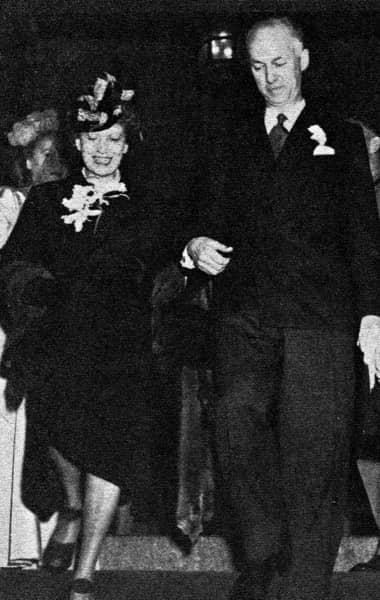
Elizabeth Arden with Edward Haslam [1884-1962].

1922 Elizabeth Arden.
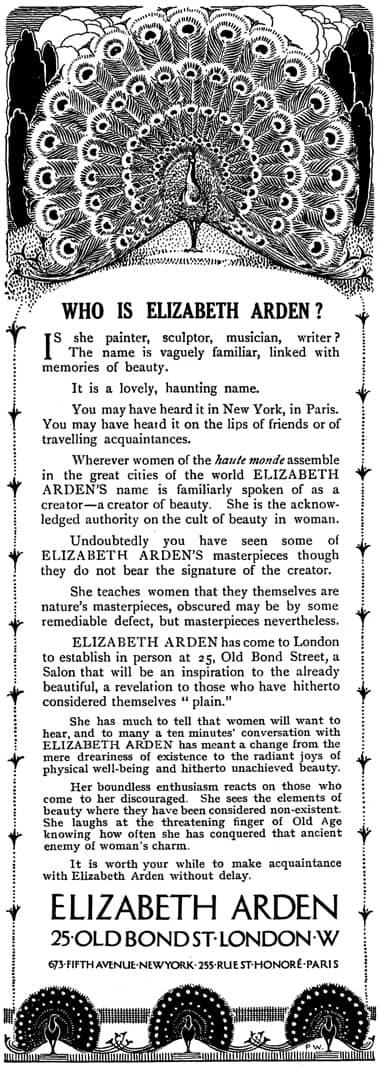
1922 Elizabeth Arden.
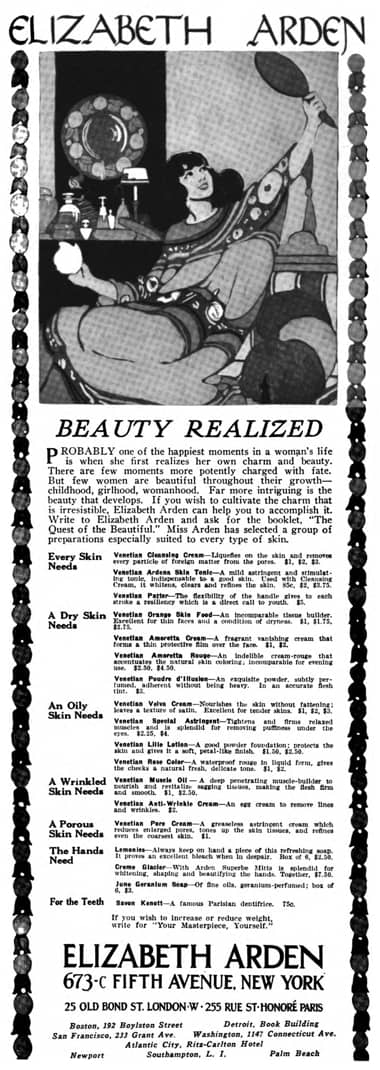
1922 Elizabeth Arden.
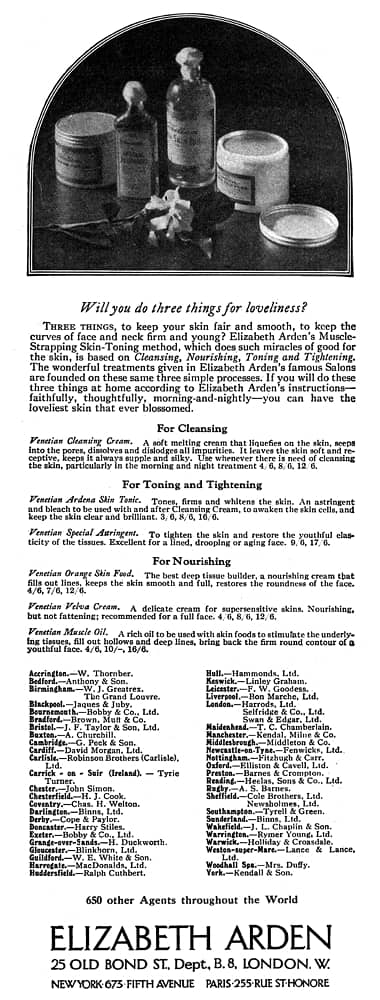
1923 Elizabeth Arden.
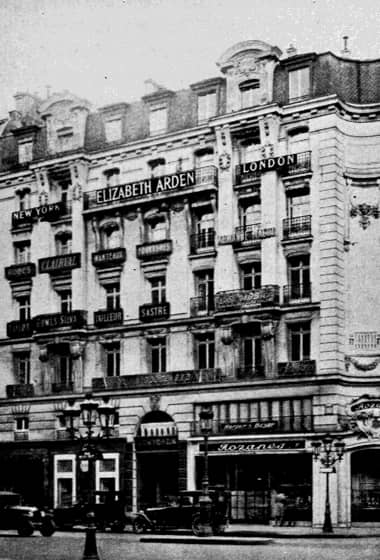
Elizabeth Arden salon d’Oro at 2 Rue de la Paix, Paris. Arden moved the Paris salon here from the Rue du Faubourg Saint-Honoré in 1923.
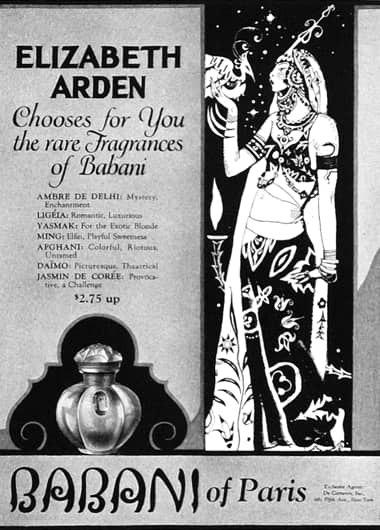
1923 Elizabeth Arden Babini Perfumes.

Henry Blackman Sell [1889-1974] when he was editor in chief at Harper’s Bazaar. In 1926, he left to join the executive editorial staff of the Butterlck Publishing Company before before moving to managing the Blaker Advertising Agency in 1928.
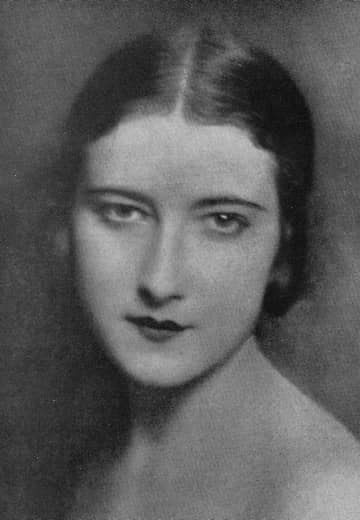
Roberte Désirée Césarine Cusey [b.1907], a french model who became Miss France in 1927. She was the face of Elizabeth Arden in the 1920s.

Photographs of an Elizabeth Arden mannequin (Wynn Richards [1888-1960]) (Detroit Institute of Arts).
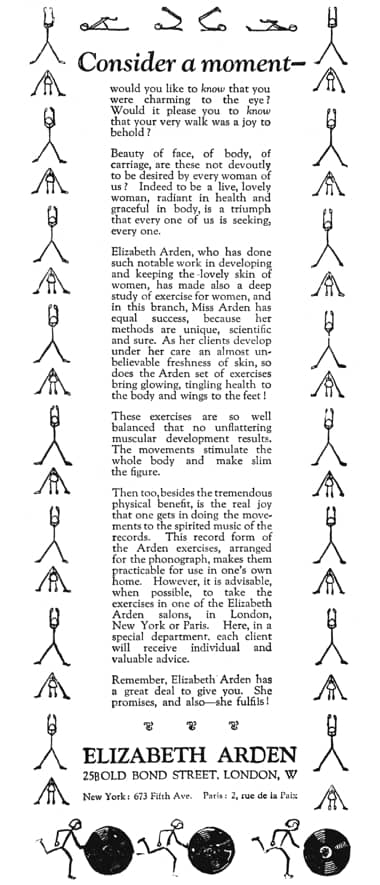
1924 Elizabeth Arden exercise program. The stick figures used in this advertisement are very similar to some used in ‘Diet and health: With key to the calories’ by Lulu Hunt Peters [1873-1930] first published in 1918.
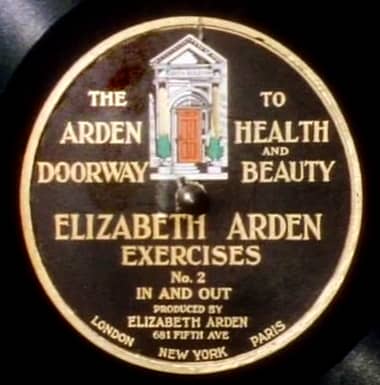
Elizabeth Arden Exercises No. 2 – In and Out – one of a set of ten exercise recordings.
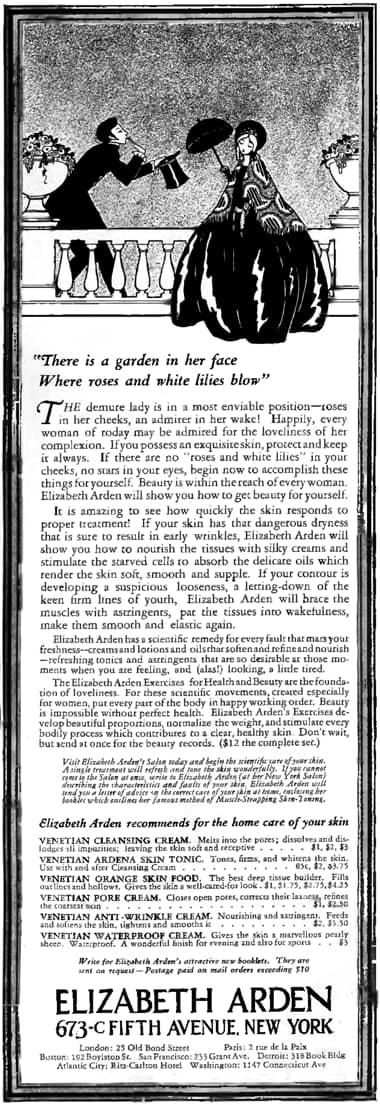
1924 Elizabeth Arden.
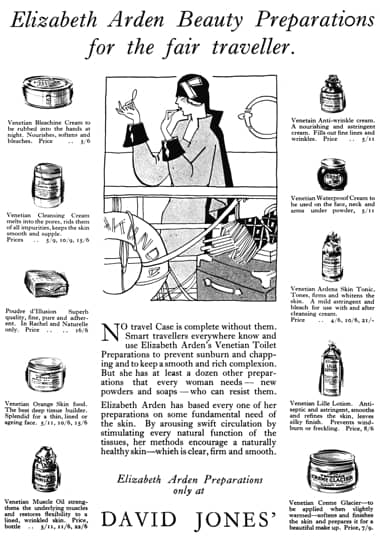
1926 Elizabeth Arden preparations for the traveller (Australia)
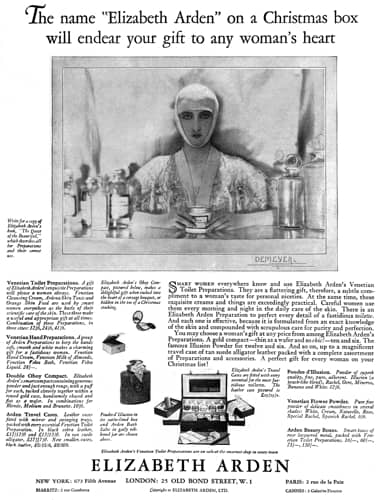
1926 Elizabeth Arden.
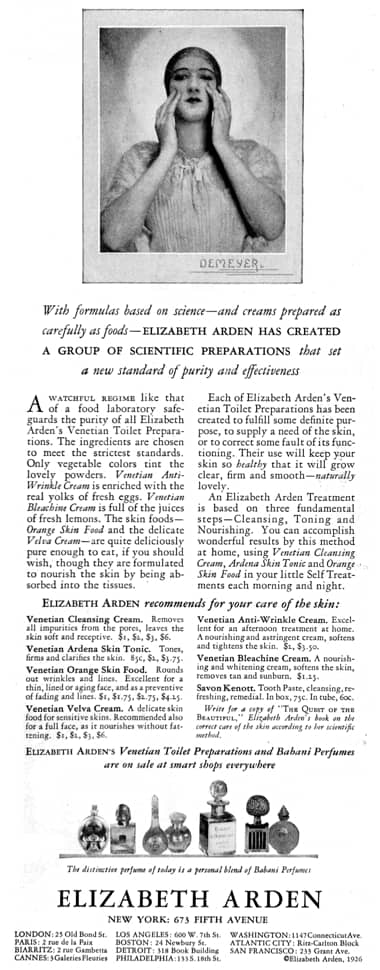
1926 Elizabeth Arden.
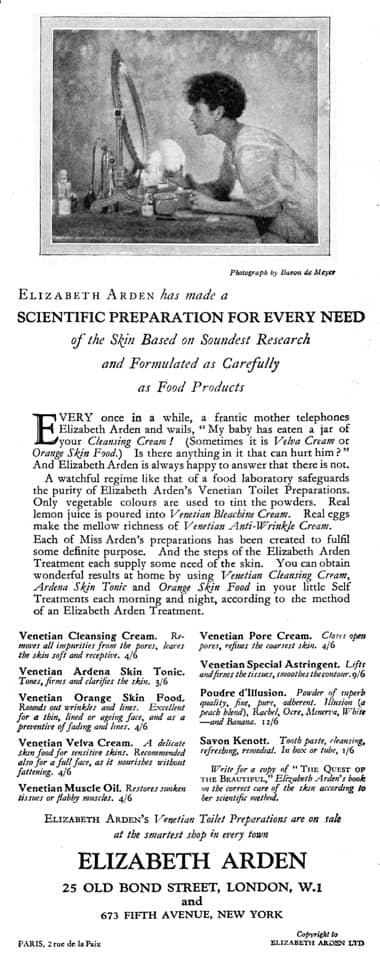
1926 Elizabeth Arden.
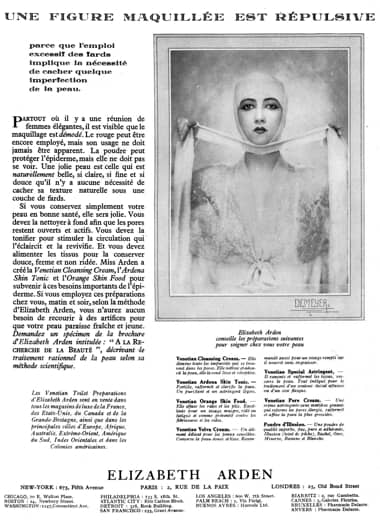
1927 Elizabeth Arden (France).
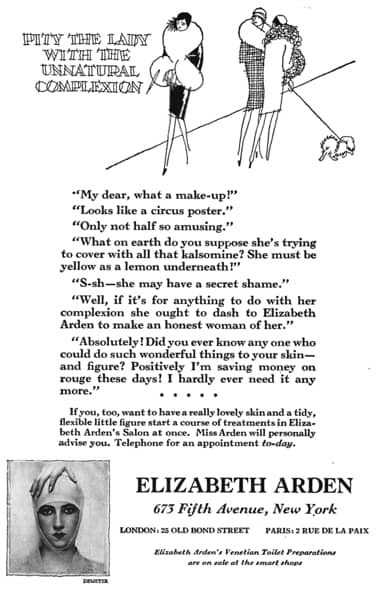
1928 Elizabeth Arden.

1929 Elizabeth Arden.
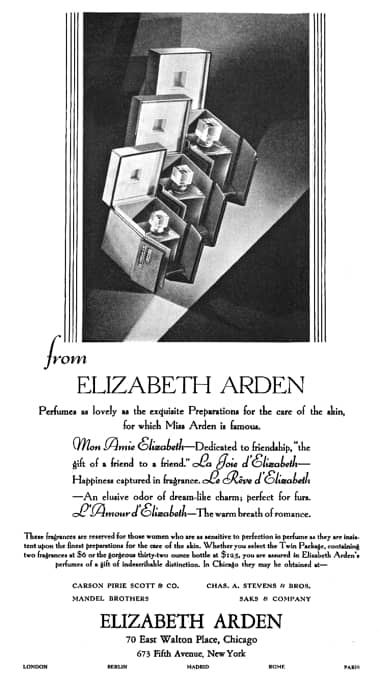
1929 Elizabeth Arden Babini fragrances: Mon Amie Elizabeth, La Joie d’Elizabeth, Le Rêve d’Elizabeth and L’Amour Elizabeth.
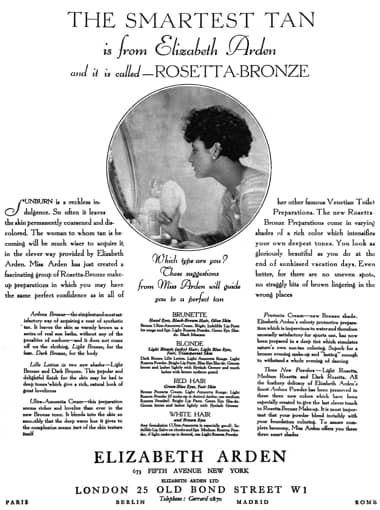
1929 Elizabeth Arden Rosetta make-up.
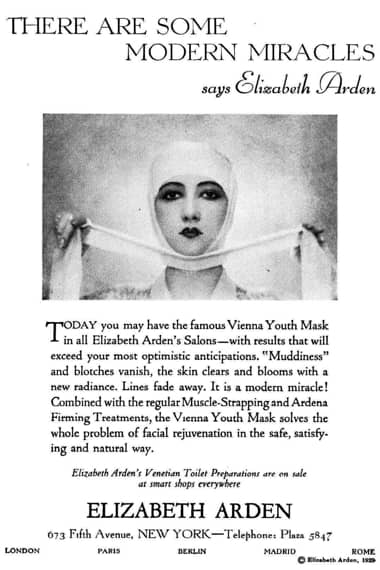
1929 Elizabeth Arden Vienna Youth Mask.
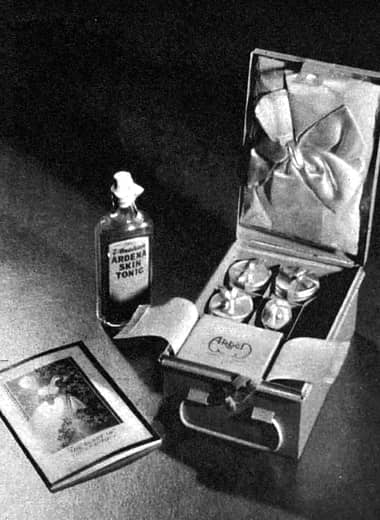
1930 Elizabeth Arden Weekend Case.
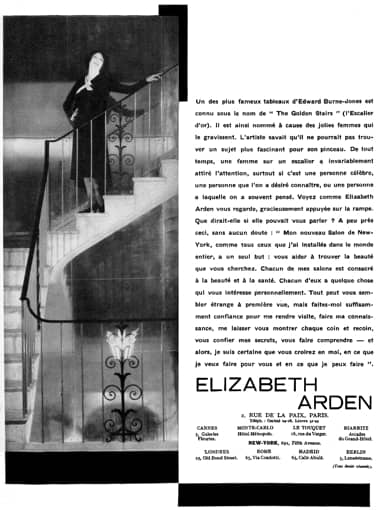
1930 Elizabeth Arden on the stairs in her new salon at 691 Fifth Avenue, New York, one of the few times she appears in an advertisement. She liked to be photographed on stairs at it made her feel taller.
